Onze truffels / Our truffles
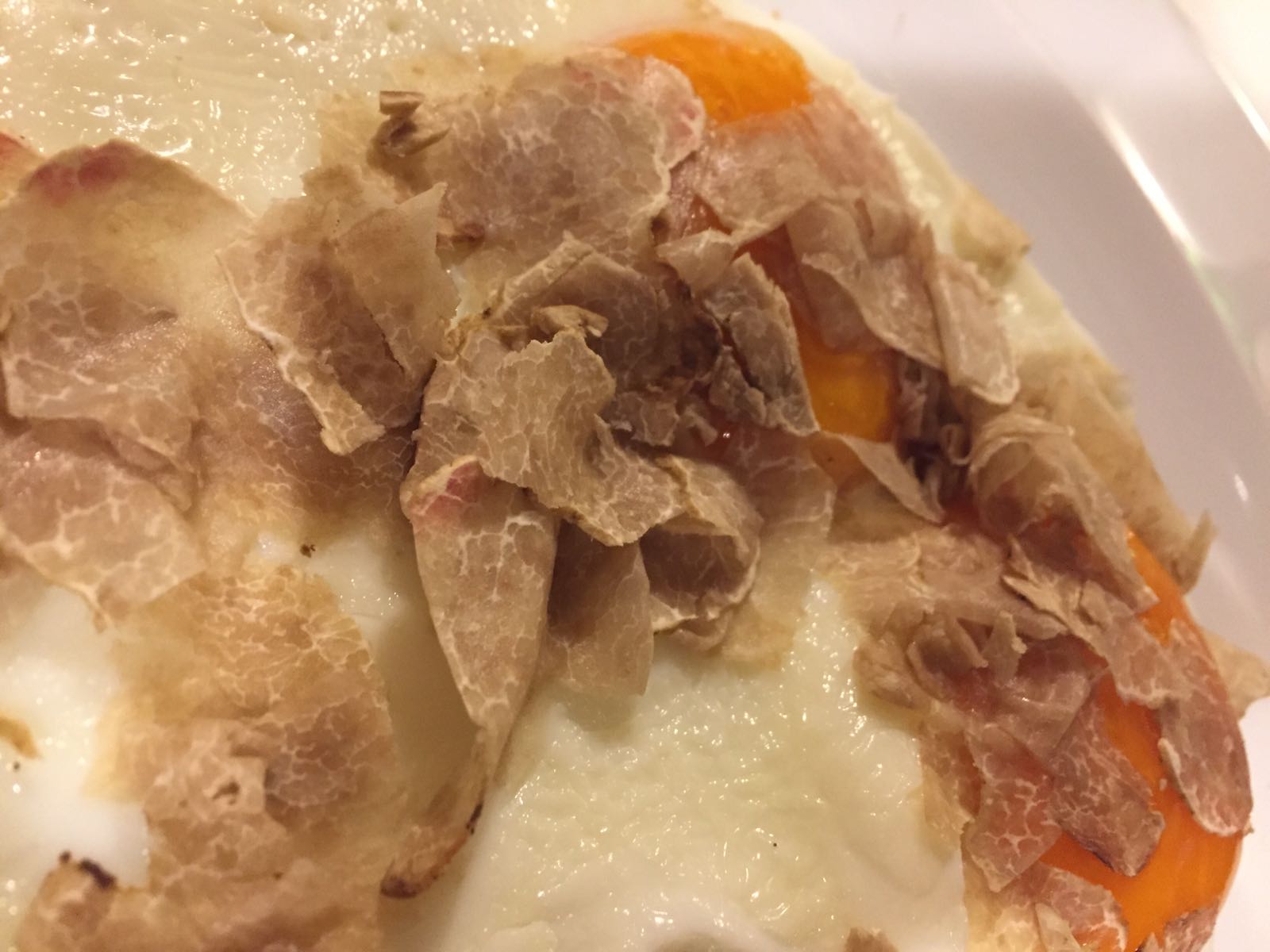 Toen ik in Triëst woonde ging ik vaak in het weekend met mijn vrienden naar Istrië eten en van zijn delicatessen genieten. Vis, olie, wijn en vooral de witte truffel! Via vrienden ontmoette ik Paolo, een jongen uit Motovun, het beste gebied voor de witte truffel. Zijn grootvader was een van de eerste truffelzoekers in Istrië. Zo begon Paolo, dankzij zijn vele contacten in de wereld van truffelzoekers en zijn passie, truffels buiten Istrië op de markt te brengen. Vandaar kwam het gemeenschappelijke idee om ze ook naar Nederland te importeren.
Toen ik in Triëst woonde ging ik vaak in het weekend met mijn vrienden naar Istrië eten en van zijn delicatessen genieten. Vis, olie, wijn en vooral de witte truffel! Via vrienden ontmoette ik Paolo, een jongen uit Motovun, het beste gebied voor de witte truffel. Zijn grootvader was een van de eerste truffelzoekers in Istrië. Zo begon Paolo, dankzij zijn vele contacten in de wereld van truffelzoekers en zijn passie, truffels buiten Istrië op de markt te brengen. Vandaar kwam het gemeenschappelijke idee om ze ook naar Nederland te importeren.
When I lived in Trieste I went often in the weekends to Istria with my friends, to enjoy the local food specialities. Fish, olive oil and especially the white truffle! Through friends I met Paolo, a young man from Motovun, the best area for the white truffle. His grandfather was one of the first truffle hunters in Istria. So Paolo began to bring truffels to the market outside Istria, thanks to his many contacts in de world of truffle hunters and to his passion. From there we came together to the idea of importing truffels to The Netherlands.
Jacopo Biadene
Voor meer informatie / For more info : info@bladenis.com
De Istrische truffel / The Istrian truffle
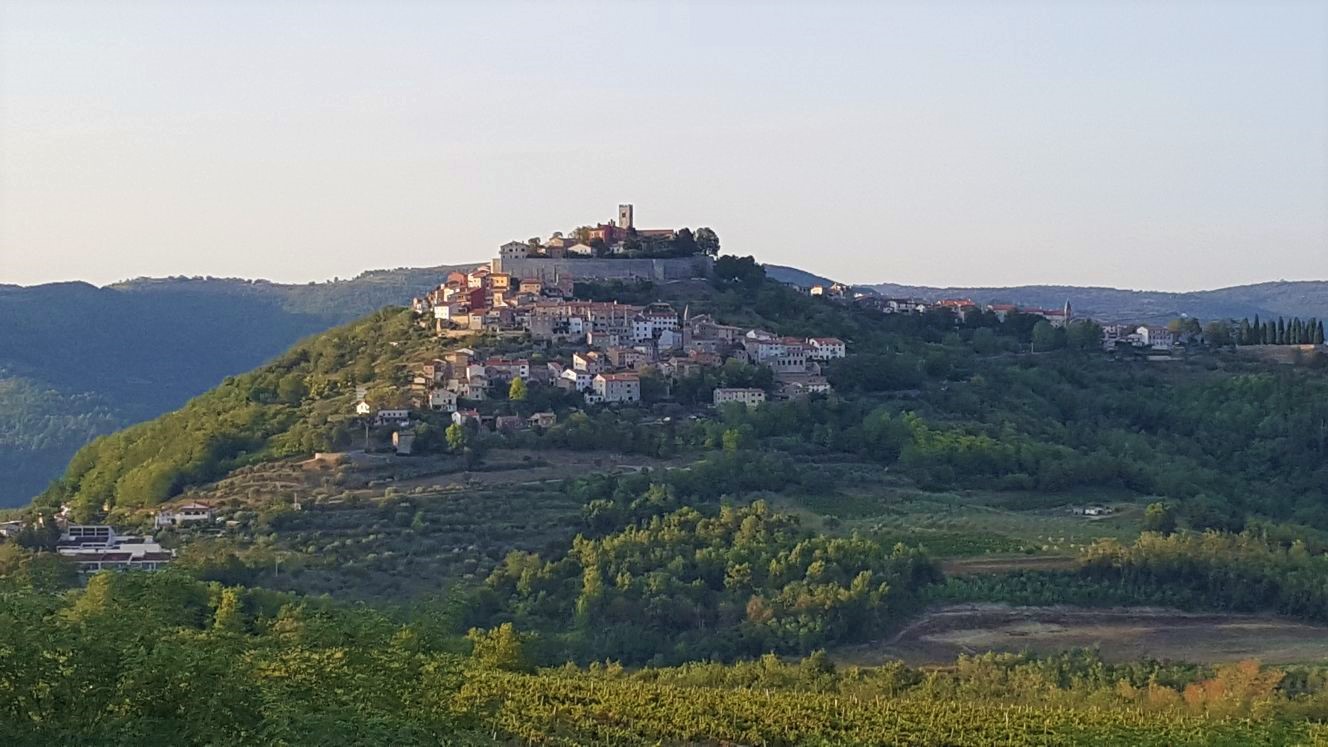
Tot voor kort was de Istrische witte truffel een onbekende op het luxueuze culinaire wereldtoneel. Hij werd luxe restaurants binnengesmokkeld en geserveerd zonder de afkomst te vermelden, of als Italiaanse truffel.
Pas aan het begin van de vorige eeuw kwam men er in Istrië achter hoe gezegend ze waren met deze gastronomische juweeltjes. Sommige uitstekende truffels groeien vrijwel het gehele jaar in Istrië, maar de meest gewaardeerde, de witte truffel Tuber magnatum pico komt pas in de herfst op de markt, waarna het seizoen ongeveer tot het einde van het jaar duurt.
Onze truffels komen vanuit het beroemde bos van Motovun, gelegen aan de rivier de Mirna, onder de muren van het prachtige gelijknamige stadje. Dit is de belangrijkste habitat van Istrië voor de witte truffel. In het bos van Motovun is ook de allergrootste witte truffel gevonden die ooit officieel is geregistreerd, met een gewicht van wel anderhalve kilo.
Ook vandaag de dag zijn deskundigen er nog niet helemaal uit hoe het kan dat de beroemde truffel uit Alba een evenknie heeft in de omgeving van Motovun en een aantal kleinere habitats in Istrië. Maar internationale conferenties van deskundigen en thematische gastronomische presentaties onder de naam Gouden truffel (Zlatni tartuf), gehouden in Kremenje bij Momjan, laten er geen twijfel over bestaan: de Istrische witte truffel doet in niets onder voor de beroemde truffels uit Alba! Sterker nog, een Amerikaanse journalist heeft ontdekt dat veel "truffels uit Alba" eigenlijk afkomstig zijn uit Istrië.
Until recently the Istrian white truffle was unknown on the world stage of luxury gastronomy. It was reaching fine restaurants of the world through smuggling, and was served either without its origin being given, or was being falsely presented as Italian.
It was only at the beginning of the last century that Istrians realized what a gastronomic jewel they had at their disposal. Several excellent types of truffles grow in Istria almost the year round, while the most treasured one, the white truffle or Tuber magnatum pico come to the market in the autumn. The truffle season lasts up to the end of the year.
Our truffles come from the famous Motovun forest, located alongside the Mirna River, at the foot of the mount upon which rises the magnificent little town of Motovun. This is the main site of Istria for the white truffel . The largest white truffle ever found, weighing almost a kilogram-and-a-half, was found in the Motovun forest.
World experts have still not decided how the famous truffle from Alba came to have a twin of equal quality in Motovun and several other smaller habitats through Istria. But the international gatherings of experts and thematic gastronomic presentations entitled Golden truffle held in Kremelje, near Momjan, arrived at a clear conclusion: the white truffle of Istria is in no way inferior to those from Alba! Indeed, an American journalist discovered that many “truffles from Alba” actually originate in Istria.
Truffel soorten / Types of truffles
Witte truffel / White truffle
Tuber magnatum (Sep 15 - Jan 31)
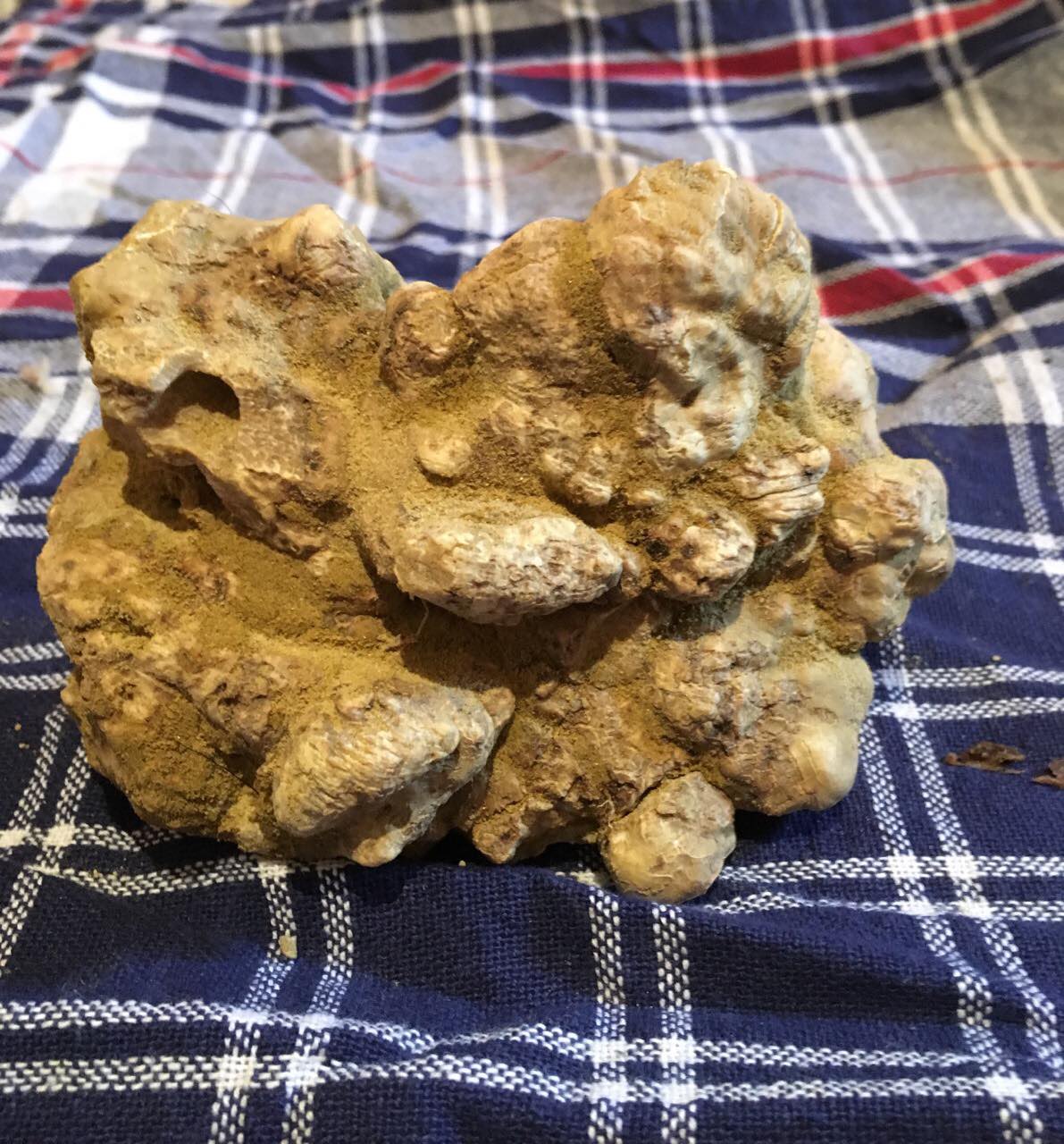 Hij kan de grootte van een grote appel bereiken. Bolvorm, vaak ook zeer afgeplat en ongelijk, met lichtgeel of goud peridium ( de buitenkant) en rode tot bruine vlekken, nooit grijs, glad of licht wratachtig. De gleba (de binnenkant), met talrijke, zeer intens vertakte witte aderen, varieert van een melkachtige kleur tot een intens roze. De huid is glad of licht wrattig. Het kan worden gevonden laat in de zomer, in de herfst en vroege winter onder eiken, wilgen, populieren en lindebomen Vanwege zijn specifieke smaak en geur werd het uitgeroepen tot culinaire koning. Het wordt rauw gegeten.
Hij kan de grootte van een grote appel bereiken. Bolvorm, vaak ook zeer afgeplat en ongelijk, met lichtgeel of goud peridium ( de buitenkant) en rode tot bruine vlekken, nooit grijs, glad of licht wratachtig. De gleba (de binnenkant), met talrijke, zeer intens vertakte witte aderen, varieert van een melkachtige kleur tot een intens roze. De huid is glad of licht wrattig. Het kan worden gevonden laat in de zomer, in de herfst en vroege winter onder eiken, wilgen, populieren en lindebomen Vanwege zijn specifieke smaak en geur werd het uitgeroepen tot culinaire koning. Het wordt rauw gegeten.
It can reach the size of a large apple. Globose shape, often also very flattened and uneven, with pale yellow or gold peridium (the external part, outside) and red to brown spots, never grey, smooth or slightly warty. Its gleba (the inner part, inside), with numerous, very intensely branched white veins, varies from a milky colour to an intense pink. The skin is smooth or slightly warty.. It can be found late in summer, in autumn and early winter under oaks, willow trees, poplars and lime trees. Due to its specific flavor and smell, it was proclaimed a culinary king. It is eaten raw.
Winter zwarte truffel / Winter black truffle
Tuber melanosporum (Nov 1 - Mar 15)
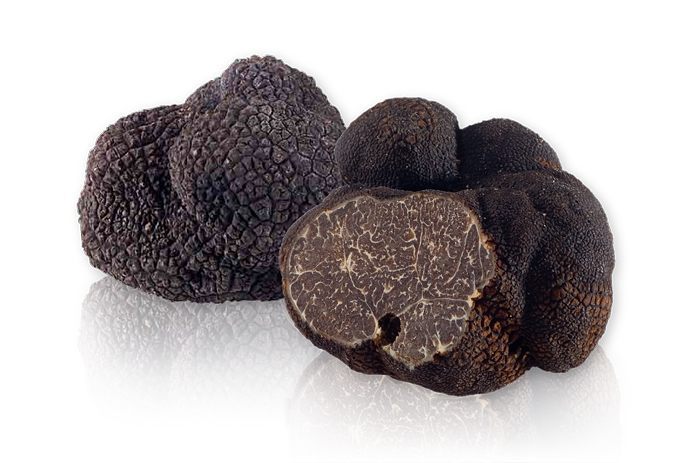 Bolvorm, soms gelobd, met bruin tot zwart peridium, met dichte wratten, hol aan de bovenkant en gekruist door longitudinale groeven. De gleba is bruinachtig grijs of roodachtig zwart van kleur, gestreept met dunne, lichte, intens vertakte aders. Het wordt verzameld gedurende de hele winterperiode en met name in de eerste maanden van het jaar, vooral onder eiken, hazelaars en haagbeuken. Het kan de grootte van een appel bereiken.Vanwege zijn specifieke smaak en aromatische geur, wordt het hoog aangeschreven in de culinaire kunsten. De Fransen beschouwen het als de hoogste kwaliteit zwarte truffel. Het wordt bij voorkeur gegeten na een korte bereiding.
Bolvorm, soms gelobd, met bruin tot zwart peridium, met dichte wratten, hol aan de bovenkant en gekruist door longitudinale groeven. De gleba is bruinachtig grijs of roodachtig zwart van kleur, gestreept met dunne, lichte, intens vertakte aders. Het wordt verzameld gedurende de hele winterperiode en met name in de eerste maanden van het jaar, vooral onder eiken, hazelaars en haagbeuken. Het kan de grootte van een appel bereiken.Vanwege zijn specifieke smaak en aromatische geur, wordt het hoog aangeschreven in de culinaire kunsten. De Fransen beschouwen het als de hoogste kwaliteit zwarte truffel. Het wordt bij voorkeur gegeten na een korte bereiding.
Globose shape, sometimes lobed, with brown to black peridium, with close warts, hollow on their tops and crossed by longitudinal grooves. Its gleba is brownish grey or reddish black in colour, striped with thin, light, intensely branched veins. Its coal-black skin is covered with flattened warts dented at the top and longitudinally grooved. It is gathered during the whole winter period and in particular in the first months of the year, especially under oaks, hazels and hop hornbeams. It can reach the size of an apple. Due to its specific flavor and aromatic scent, it is highly regarded in culinary arts. The French consider it the highest-quality black truffle. It is preferably eaten after a short cooking.
Winter zwarte truffel “brumale” / Winter black truffle “brumale”
Tuber brumale (Oct 1 - Mar 15)
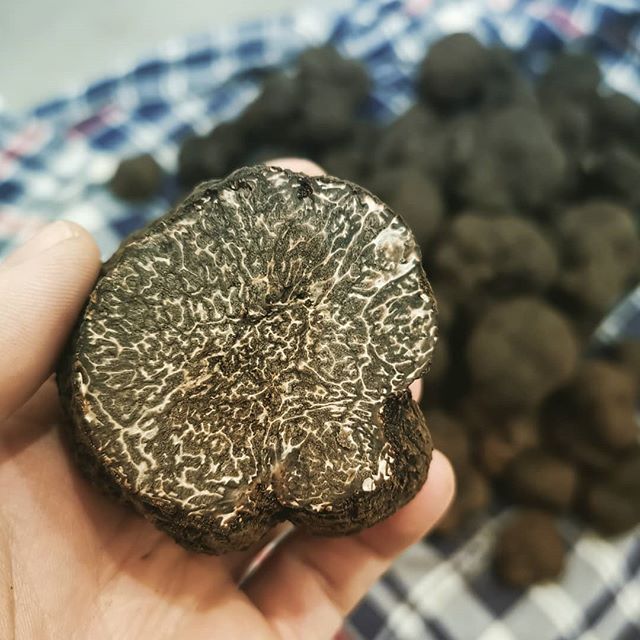 Meestal bolvormig in scherp of een beetje gelobd, met zwart of donker ijzerperidium, met zeer nauwe, duidelijke wratten, hol aan de bovenkant en met longitudinale groeven. De gleba is donkerbruin of grijsachtig zwart met grote witte nerven. Het kan gemakkelijk groter worden dan een kippenei. Het kan worden gevonden in de herfst en vroege winter onder eiken en hazelaars. De geur en smaak zijn min of meer sterk maar aangenaam (met name in de variëteit moschatum Ferry) en zorgen ervoor dat het normaal wordt geconsumeerd.
Meestal bolvormig in scherp of een beetje gelobd, met zwart of donker ijzerperidium, met zeer nauwe, duidelijke wratten, hol aan de bovenkant en met longitudinale groeven. De gleba is donkerbruin of grijsachtig zwart met grote witte nerven. Het kan gemakkelijk groter worden dan een kippenei. Het kan worden gevonden in de herfst en vroege winter onder eiken en hazelaars. De geur en smaak zijn min of meer sterk maar aangenaam (met name in de variëteit moschatum Ferry) en zorgen ervoor dat het normaal wordt geconsumeerd.
Usually globose in sharpe or a little lobed, with black or dark iron peridium, with very close, evident warts, hollow on the top and with longitudinal grooves. Its gleba is dark brown or greyish black with large white veins. It can easily become bigger than a hen's egg. It can be found in autumn and early winter under oaks and hazels. Its smell and its taste are more or less strong but pleasant (in particular in its variety moschatum Ferry) and make so that it is normally consumed.